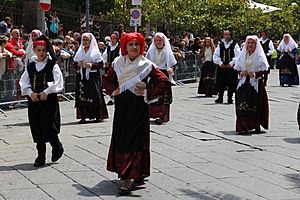Carbonia facts for kids
Quick facts for kids
Carbonia
|
|
|---|---|
| Comune di Carbonia | |
 |
|
| Country | Italy |
| Region | Sardinia |
| Province | Sud Sardegna |
| Area | |
| • Total | 145.54 km2 (56.19 sq mi) |
| Elevation | 111 m (364 ft) |
| Population | |
| • Total | 28,581 |
| • Density | 196.379/km2 (508.619/sq mi) |
| Time zone | UTC+1 (CET) |
| • Summer (DST) | UTC+2 (CEST) |
| Postal code |
09013
|
| Dialing code | 0781 |
| Website | http://www.comune.carbonia.ci.it |
Carbonia (which means coal town in Italian) is a town and a comune (like a municipality) located on the sunny island of Sardinia, in Italy. It's part of the Province of Sud Sardegna. In 2016, about 28,581 people lived there. The town covers an area of 145.54 square kilometers (about 56 square miles) and sits 111 meters (364 feet) above sea level.
Contents
What is Carbonia?
Carbonia is a relatively new town compared to many others in Italy. It was built in the late 1930s. The town's name, "Carbonia," gives a big clue about why it was created. It comes from the Italian word carbone, meaning coal. This town was specifically built to support the important coal mining industry in the area.
Where is Carbonia Located?
Carbonia is found in the southwestern part of Sardinia. This part of the island is known for its rich natural resources, especially coal. The town is surrounded by a landscape that shows its mining past, with hills and valleys shaped by centuries of work. Being on an island, Carbonia is not far from the coast, though it's not directly on the sea.
A Brief Look at Carbonia's History
Carbonia's history is quite unique because it's a planned town. It was designed and built very quickly to house the many miners who came to work in the nearby coal mines.
The Coal Mining Era
The town was officially founded in 1938. It grew rapidly as more and more people moved there for mining jobs. Coal was a very important resource for Italy at the time, especially during World War II. The mines around Carbonia produced a lot of coal, making the town a key industrial center. Many buildings in Carbonia, like the miners' homes and public buildings, were built during this period. They often have a distinct architectural style from the 1930s.
After the Mines Closed
After World War II, the demand for coal slowly decreased. Many of the mines around Carbonia eventually closed down. This was a big change for the town, as many people lost their jobs. Carbonia then had to find new ways to support its people. Today, the town is working to develop other industries, like tourism and services. It also tries to remember its mining heritage through museums and cultural sites.
Life in Carbonia Today
Even though the coal mines are mostly closed, Carbonia remains an important town in the region. It serves as a center for the surrounding communities.
Education and Culture
Carbonia has schools for children and teenagers, as well as other public services. There are also museums that tell the story of the town's mining past. These museums help visitors and young people understand the hard work and history that shaped Carbonia. They often show tools, photos, and stories from the miners' lives.
Local Economy and Activities
Today, the economy of Carbonia is more diverse. People work in various jobs, including services, small businesses, and some light industries. The town also benefits from its location near beautiful natural areas in Sardinia, which attracts some tourists. Local markets and shops provide goods and services for the residents.

